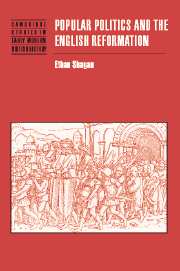Book contents
- Frontmatter
- Contents
- Acknowledgements
- List of abbreviations
- Note on the text
- Introduction
- Part I The break with Rome and the crisis of conservatism
- 1 ‘Schismatics be now plain heretics’: debating the royal supremacy over the Church of England
- 2 The anatomy of opposition in early Reformation England: the case of Elizabeth Barton, the holy maid of Kent
- 3 Politics and the Pilgrimage of Grace revisited
- Part II Points of contact: the Henrician Reformation and the English people
- Part III Sites of Reformation: collaboration and popular politics under Edward VI
- Conclusion
- Bibliography
- Index
- Cambridge Studies in Early Modern British History
2 - The anatomy of opposition in early Reformation England: the case of Elizabeth Barton, the holy maid of Kent
Published online by Cambridge University Press: 05 July 2009
- Frontmatter
- Contents
- Acknowledgements
- List of abbreviations
- Note on the text
- Introduction
- Part I The break with Rome and the crisis of conservatism
- 1 ‘Schismatics be now plain heretics’: debating the royal supremacy over the Church of England
- 2 The anatomy of opposition in early Reformation England: the case of Elizabeth Barton, the holy maid of Kent
- 3 Politics and the Pilgrimage of Grace revisited
- Part II Points of contact: the Henrician Reformation and the English people
- Part III Sites of Reformation: collaboration and popular politics under Edward VI
- Conclusion
- Bibliography
- Index
- Cambridge Studies in Early Modern British History
Summary
On 20 April 1534, Elizabeth Barton and five of her associates died traitors' deaths at Tyburn, their heads afterwards displayed on pikes along London Bridge as a deterrent to other malcontents. According to the authorities, they had committed the most heinous of crimes. Not only had they promoted ‘blasphemy of almighty God, whereby a great multitude of people of this realm were … induced to idolatry’, but they had also ‘brought in a murmur and grudge amongst themselves, to the great peril of the destruction of our said sovereign lord and his succession, and to the jeopardy of a great commotion, rebellion, and insurrection in this realm’. In short, they had publicly manoeuvred to incite opposition against Henry VIII, his divorce from Catherine of Aragon, and the break with Rome. The government, fearful not only of Barton and her co-conspirators but also of the effect their agitation was having in the countryside, supplemented their executions with a remarkable propaganda blitz. Sermons against Barton and her associates were preached, proclamations against their activities were read throughout the realm, and subjects were given forty days to surrender any books concerning Barton in their possession or else face the law's fury themselves.
What is so strange about this incident is not the execution of the traitors, nor the regime's obvious fear of their activities, but rather the identity of the main protagonist: Elizabeth Barton hardly fit the typical profile of Public Enemy Number One in sixteenth-century England.
- Type
- Chapter
- Information
- Popular Politics and the English Reformation , pp. 61 - 88Publisher: Cambridge University PressPrint publication year: 2002



